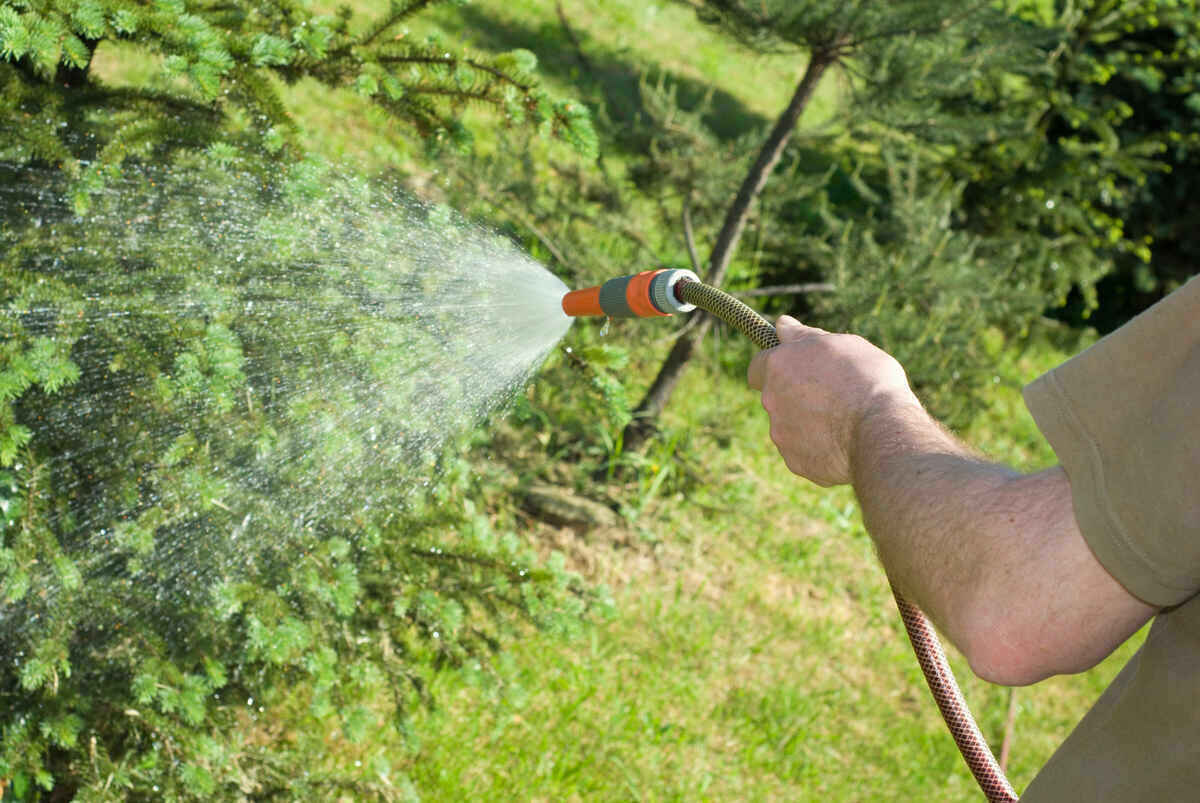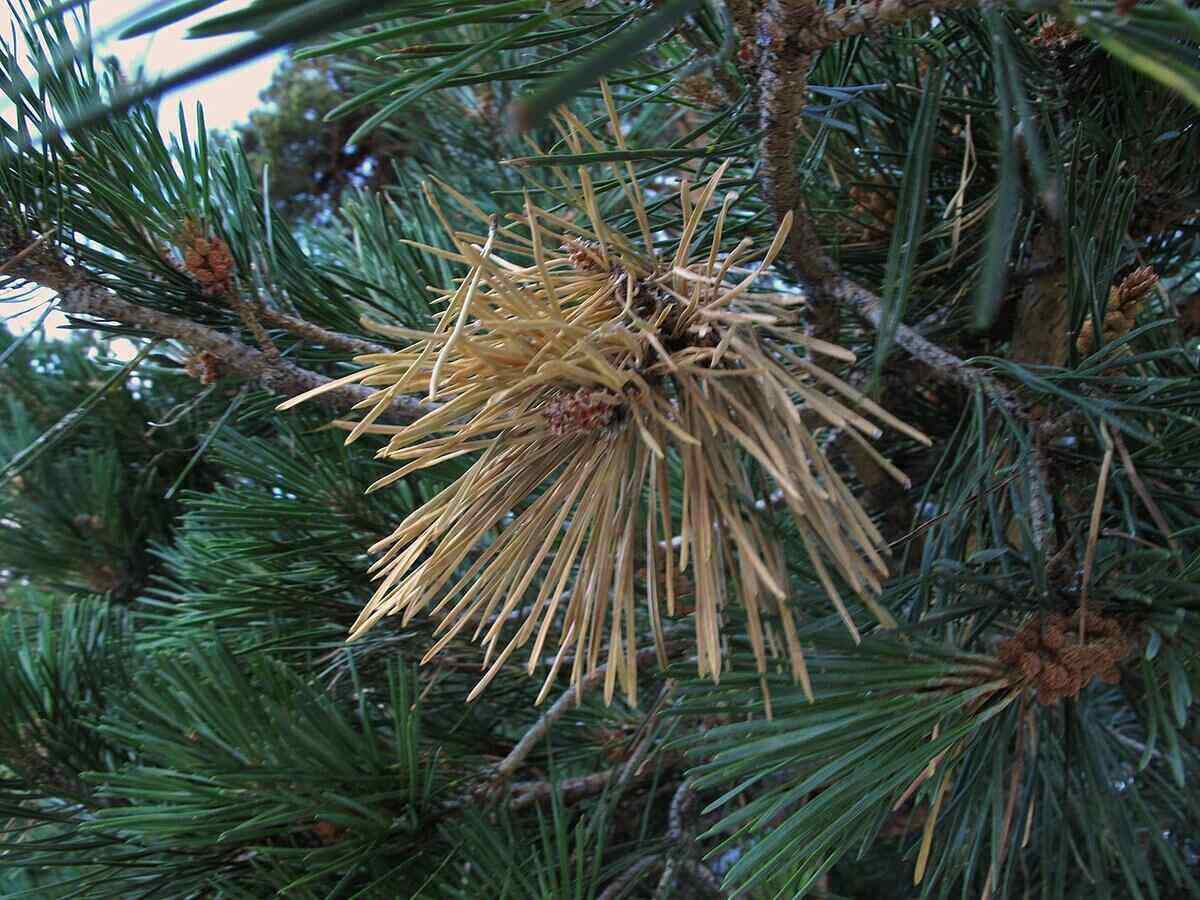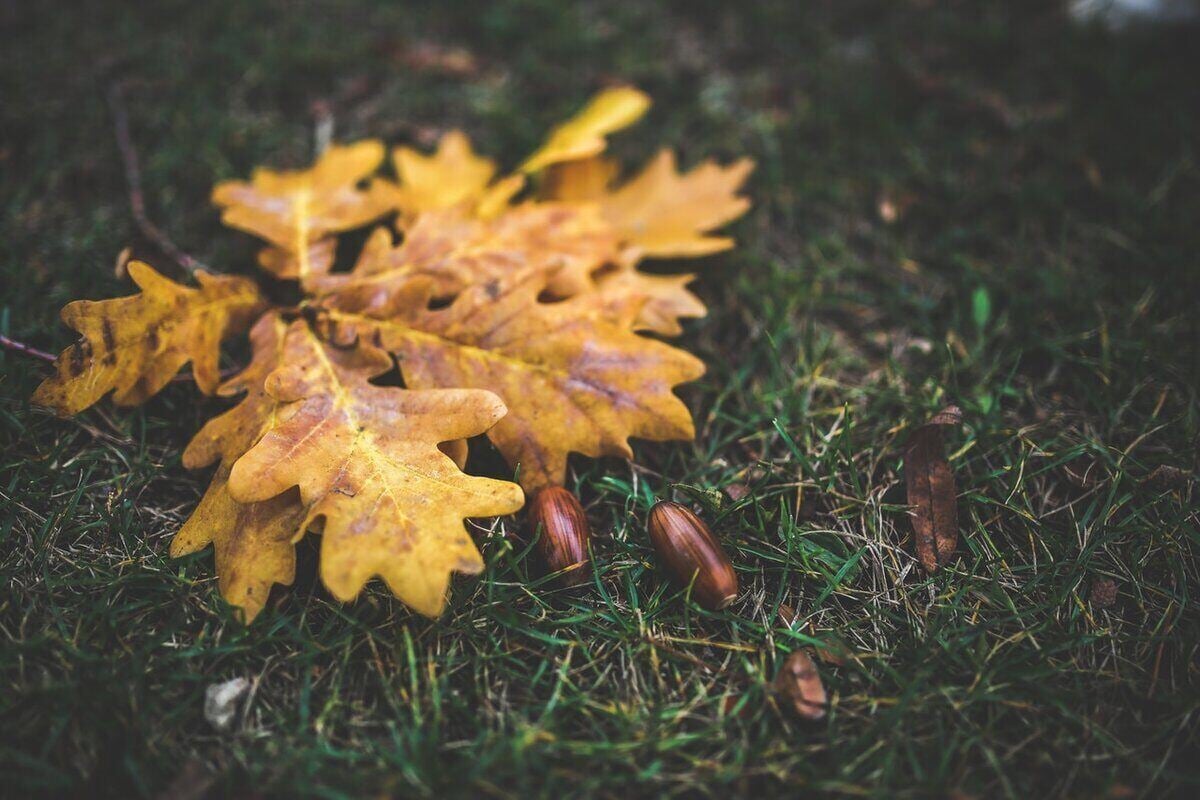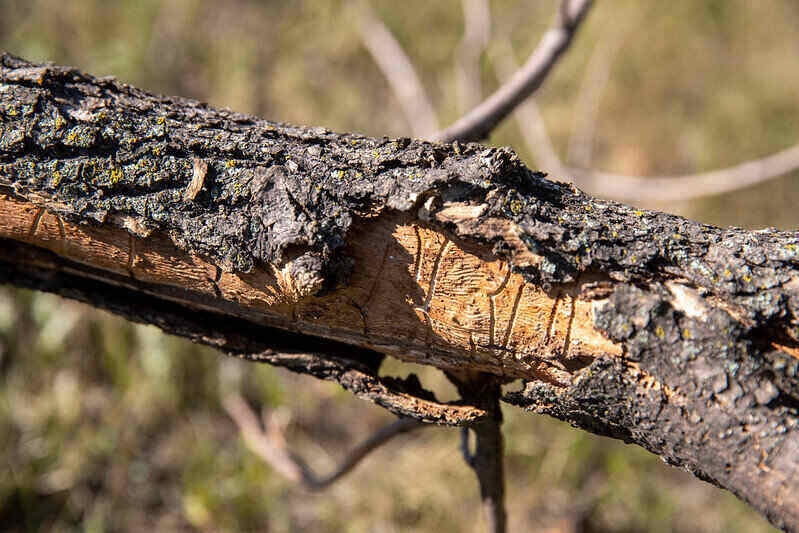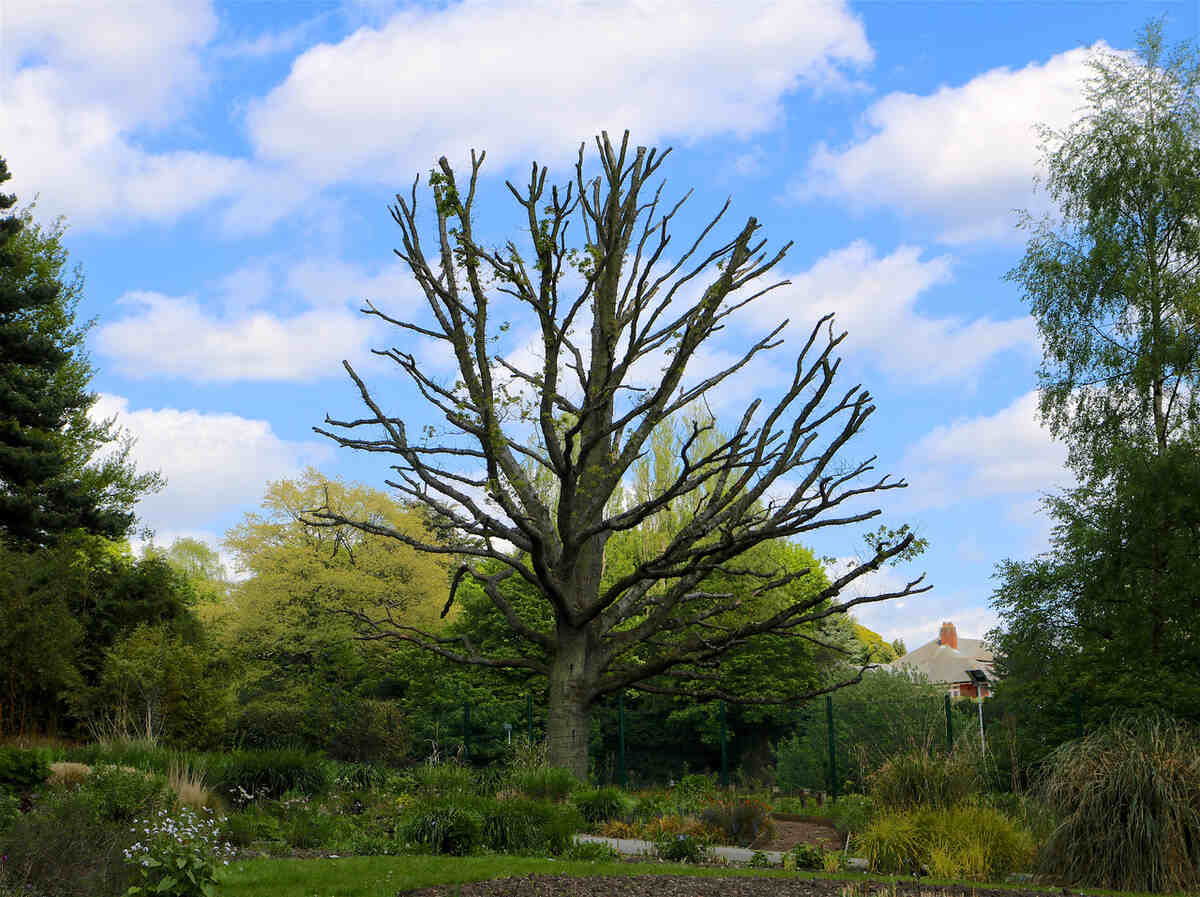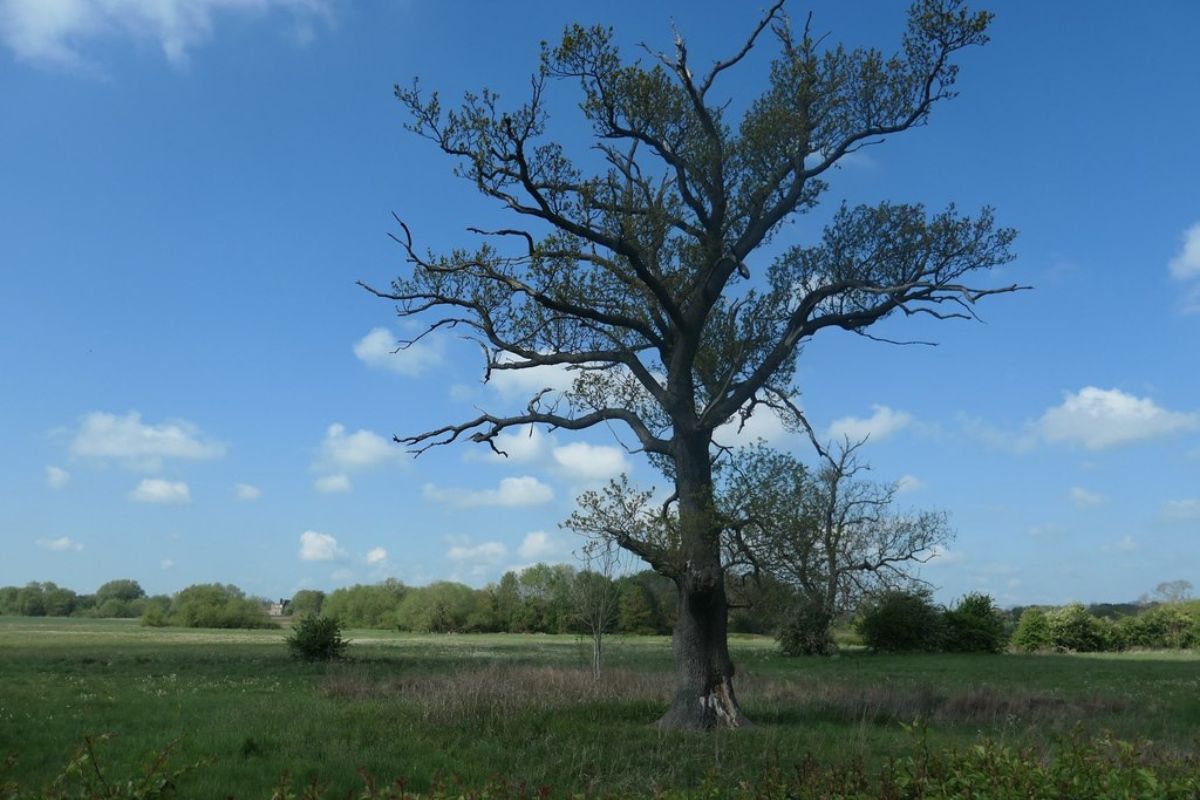
Don’t wait until your tree comes crashing down in your yard or on your home before realizing your tree was in distress. Recognize the 13 signs your tree is dying so you can save it before it makes its way into your living room.
13 Signs of a Dying Tree
Much like a young child, a tree may not be able to tell you where it hurts. But, there are warning signs to look for that may show it’s in distress. Knowing the signs and when to call an expert could make a life-or-death difference for your tree.
Leaves and branches may be the obvious place to look for signs of trouble, but don’t forget to closely inspect the whole tree. All parts of the tree hold clues to what may be happening deep inside the tree or below the ground.
1. Root Damage
The roots are one of the most crucial parts of a tree. They are what hold the tree into the ground and deliver essential nutrients from the soil. Always take care whenever doing projects or mowing near trees as to not damage the roots.
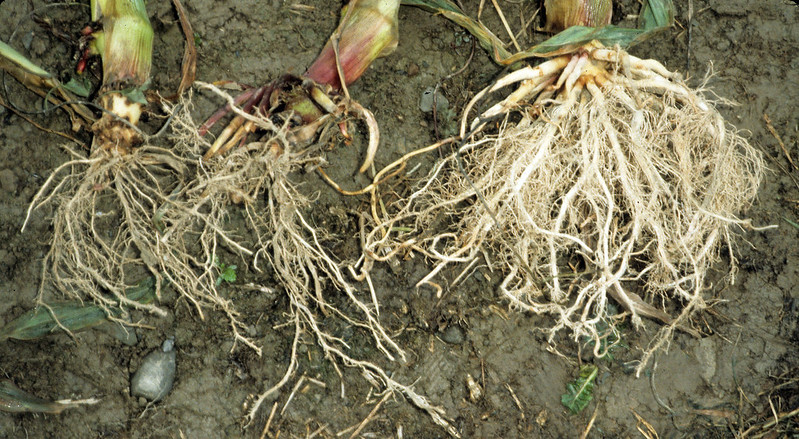
Cause: Construction and landscaping projects often disrupt the soil around a tree causing distress. Damage also can be caused by lawnmowers or weed eaters if you get too close to the trunk or roots.
Cure: Make sure your tree is getting enough water, aerate the soil around the roots, apply mulch around the tree, and provide support, if needed. An arborist will be able to safely remove the tree if it is too damaged to repair.
2. Tree is Leaning
A leaning tree could signal damaged or dying roots as well as general weakness or a structural imbalance.
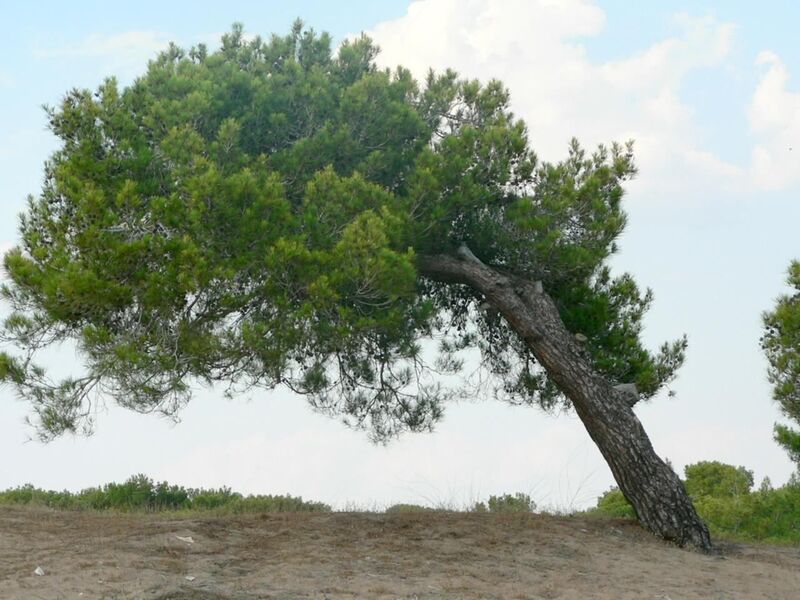
Cause: A leaning tree is often the result of a strong storm sweeping through your town. A tree leaning more than 15 degrees is typically a sign of wind or root damage and is unlikely to recover.
Cure: You may be able to brace the tree to keep it from toppling over. However, in most cases, it’s too late to save the tree by the time it begins to lean. It’s best to call a certified tree specialist to evaluate the tree and come up with a game plan.
3. Heaving Soil
A tree with heaving soil around its base typically indicates a problem with its roots which could include dead, broken, or diseased roots.
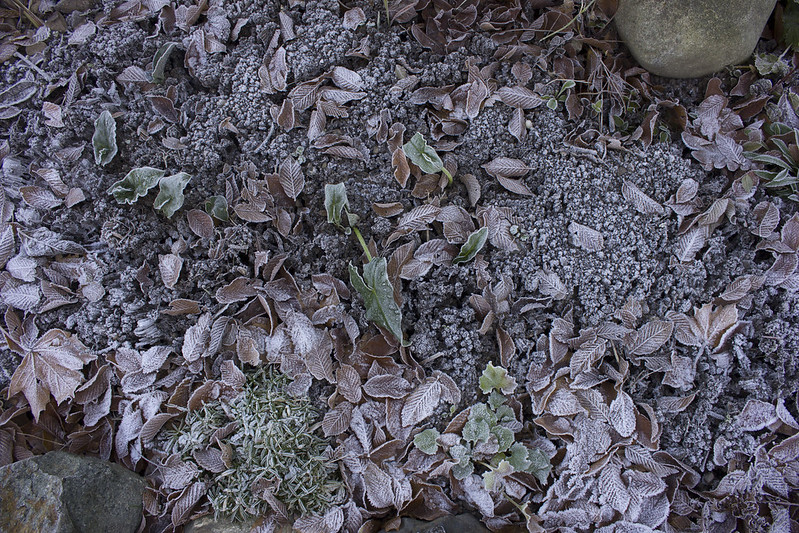
Cause: Roots exposed due to heaving soil could signal a tree doesn’t have enough space to grow. It also may be a result of excessive rainfall. Completely saturated soil along with wind from a storm can displace soil causing exposed tree roots or the soil to heave.
Cure: You’ll want a certified arborist to evaluate signs of heaving soil, due to structural safety concerns. They will be able to evaluate if your tree can be uprighted, staked, or if it will need to come down.
4. Bark Falling Off
Flaking or peeling tree bark can be a symptom the tree isn’t receiving enough nutrients. But if bark loss is from an infectious condition, you will want to cut it down before it can infect any healthy trees.
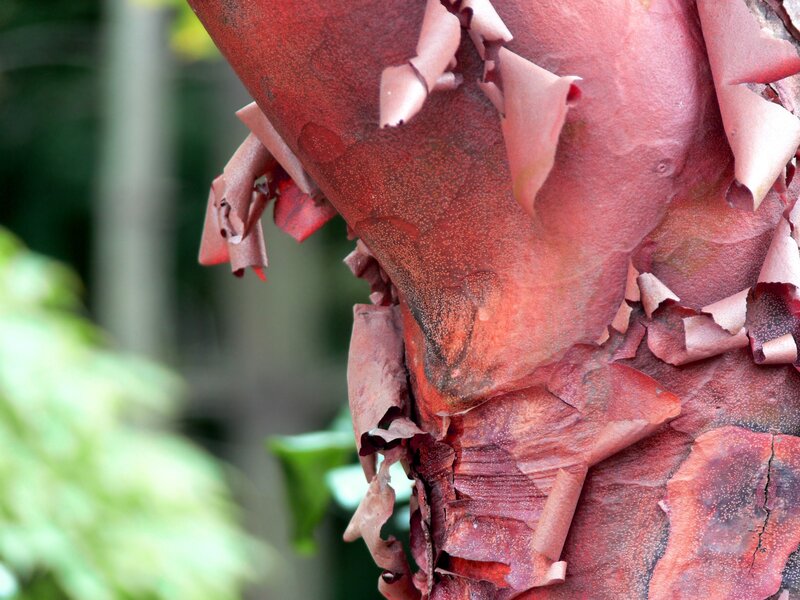
Cause: Hypoxylon canker and boring insects are two common causes a tree may be lacking nutrients. A hypoxylon canker is an untreatable fungus that causes the bark to fall from a tree’s trunk. It typically attacks an already distressed tree. Boring insects, like the bark beetle or carpenterworms, also typically attack a tree already in a decline, setting up residence inside a dying tree and feeding on what’s still living.
Cure: If the only symptom your tree is experiencing is peeling bark, it’s likely due to weather stress. If this is the case, be sure you hydrate the tree properly, particularly if the weather stress is due to drought. Applying mulch in the spring and fall is another way to combat any weather stresses your tree may be experiencing. However, if the bark loss is from an infectious condition, contact an arborist before it has a chance to infect any other trees or nearby plants.
5. No Green Under the Bark
If your tree fails the scratch test and shows a lack of green under the surface of the bark this may indicate a problem with nutrient flow. Dead twigs and brittle branches also often accompany this symptom.
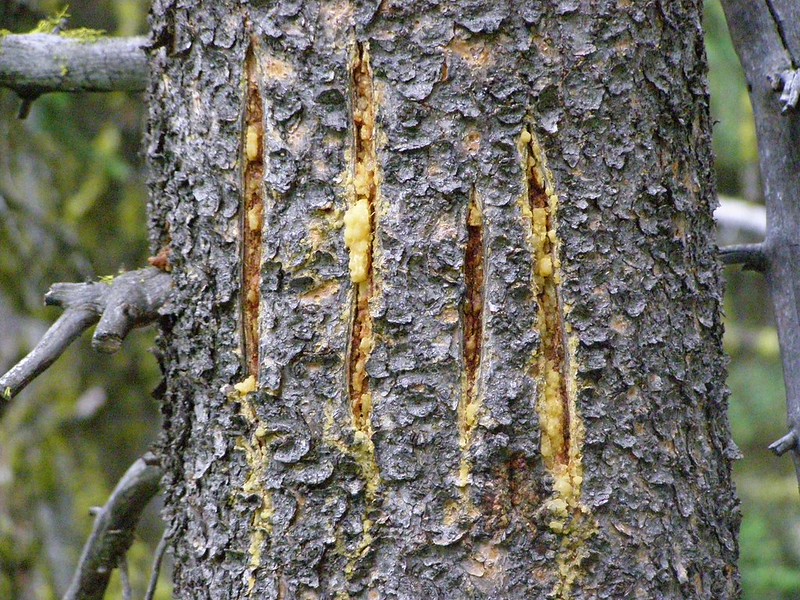
Cause: A nutrient flow problem could spring from a number of different factors. It could signal it’s not getting enough sunlight or water. Or maybe something like a fungus or insect infestation is blocking the nutrients from reaching their destination.
Cure: Typically a tree that fails the scratch test is dead or in the process of dying. You’ll want to consult an arborist to evaluate the extent of the problem and recommend a plan of action.
6. Rot or Fungus
Fungus is typically a muted tan color but also can be orange or red and is often a sign of decay. Mushrooms or fungal bodies growing around the root system or on the tree trunk is a sure sign of internal rot.
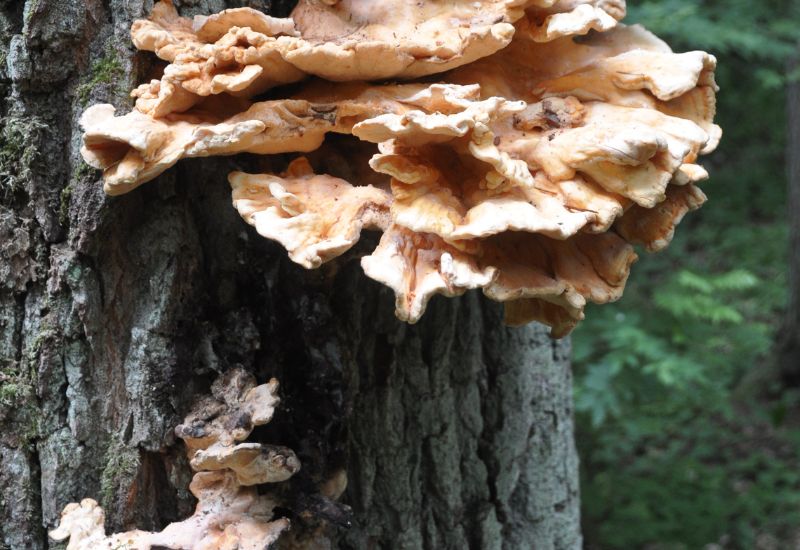
Three Types of Tree Rot
- White Rot: Wood will have a white or yellow color and feel moist, soft, spongy, or stringy.
- Brown Rot: This will produce dry and fragile wood that will crumble into cubes. The decay often forms columns of rot.
- Soft Rot: Grows slower than brown or white rot and is caused by both bacteria and fungi.
Cause: There are many types of fungi that feed on dead or decaying trees and can be introduced to your tree in a number of ways. Fungal spores can be carried to your trees by winds transporting spores, rain splashing spores onto trees, contaminated gardening tools, and human or animal movement.
Cure: If caught early, you may be able to save the tree by removing the infected limbs. You also can try decay management fungicides if the damage hasn’t spread. However, prevention is the name of the game with tree rot or fungus as it can be very tricky to identify the type of fungus, even for professionals. Proper watering, sunlight, mulching, and fertilizing can help keep fungus at bay.
7. Oozing Sap or Sawdust
Sawdust or sap oozing from holes are often signs you may have a borer insect problem. These insects damage trees by tunneling inside the inner bark layer and into the sapwood which transports nutrients and water to the leaves. Essentially, these pests will starve and even compromise the physical integrity leading to the tree’s death.
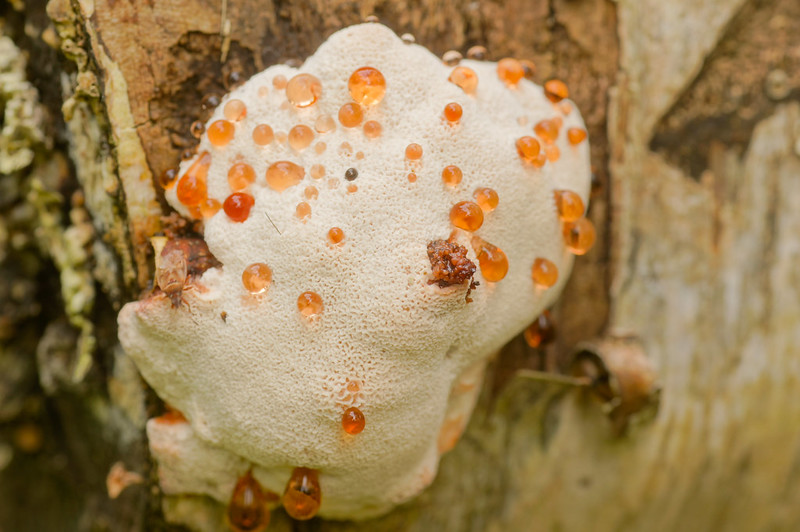
Cause: A borer insect is often the culprit responsible for oozing sap or sawdust. Left untreated the tree will die.
Common Borer Insects
- Clearwing Borers
- Dogwood
- Lilac
- Banded Ash
- Peachtree
- Rhododendron
- Flatheaded Borers
- Emerald Ash
- Bronze Birch
- Flatheaded Appletree
Cure: If you have identified the specific borer, you can target it with insecticide. If you are unable to identify the type of pest, a certified tree specialist will be able to help identify and treat the pest. They also will be able to assist with removal if the tree is deemed structurally unstable.
Pro tip: It is always easier to prevent than to treat an infestation. Bark sprays with contact insecticides may help prevent an infestation.
8. Bug Infestation
Trees can fall prey to many types of pests, including termites, certain beetles, mites, ants, caterpillars, and more. If caught early, you may be able to save the tree. But once a tree becomes unstable, it’s probably best to have it removed before it can fall on someone or something.
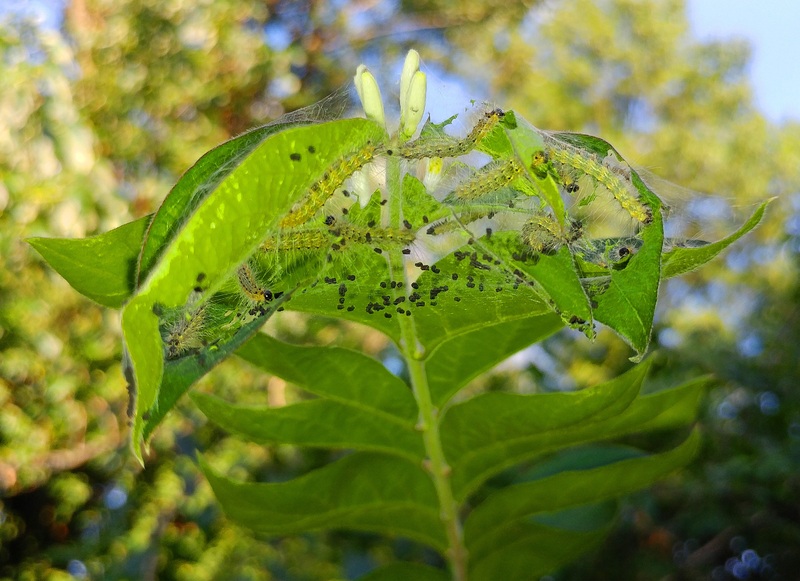
Cause: Often pests are drawn to already damaged trees. An injury, whether created by man or Mother Nature, leaves a tree vulnerable to pests moving in and taking up residence.
Common Tree Pests
- Sucking Pests
- Aphids
- Scale Insects and Mealybugs
- Lace Bugs
- Whiteflies
- Spider Mites
- Chewing Pests
- Tent Caterpillars
- Fall Webworms
- Bagworms
- Beetles
- Boring Pests
- Dogwood
- Lilac
- Banded Ash
- Peachtree
- Rhododendron
- Emerald Ash
- Bronze Birch
- Flatheaded Appletree
For more information about tree pests check out this article about problems brought on by insects and diseases.
Cure: You may be able to control some pests with proper pruning, watering, and sunlight. But when more is needed, this article will help point you to the right insecticide for your specific pest problem. If you have trouble identifying the type of pest attacking your tree, call in a tree expert to help you diagnose and treat the problem.
9. Open Wounds
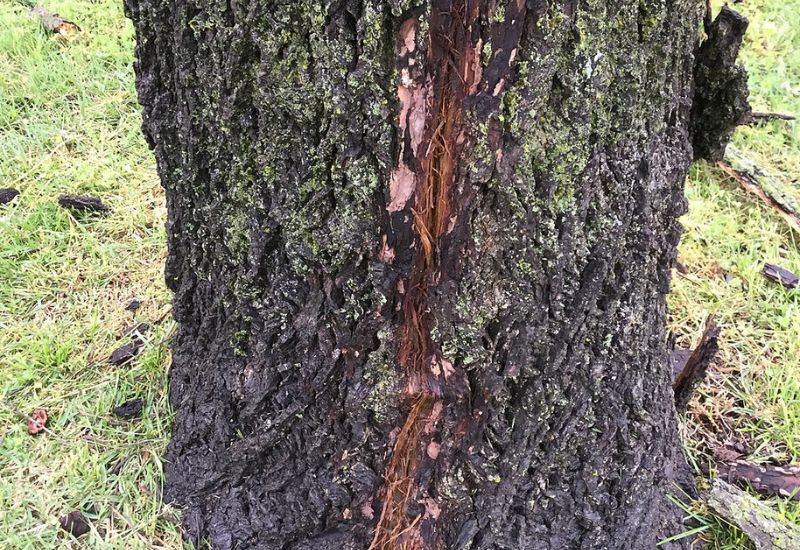
Much like humans, trees have the ability to heal their wounds. However, sometimes a tree may need a little assistance healing.
Cause: Open wounds can happen when Mother Nature strikes through wind or lightning and may cause a tree to split. Humans also cause open wounds through pruning or other accidental damage during lawn mowing or construction projects.
Cure: Cut off any ragged edges but be sure you don’t remove any healthy bark. Also use proper pruning practices to remove any dead, dying, or broken branches.
Pro Tip: Pruning can either help or hurt the health of a tree. Be sure you understand how to make proper cuts, and don’t leave unnecessary open wounds for unwelcome invaders.
10. Brittle Branches and Grounded Sticks
Continually seeing sticks on the ground and brittle or weak tree branches may be a sign of diseased or dead branches which could signal the majority of the tree is also dead.
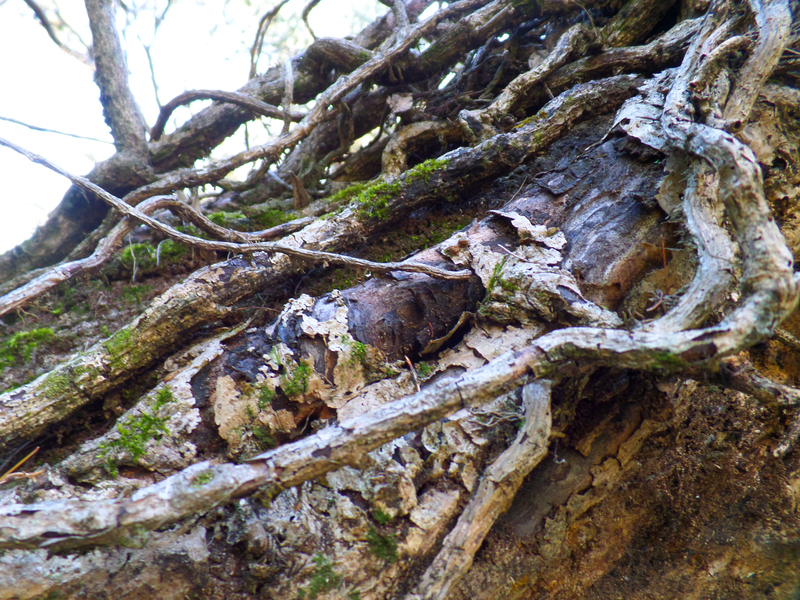
Cause: Brittle branches could be caused by stress from drought, or possibly over-fertilization. Pest infestations and diseases are also two other possible culprits.
Cure: Have the health of your trees evaluated ASAP. With the help of a professional, you may be able to save your tree, but you will first want a proper diagnosis and action plan.
11. No Leaves
Bare branches are a sure sign that something is wrong. A lack of leaves could be a sign of malnutrition or internal decay.
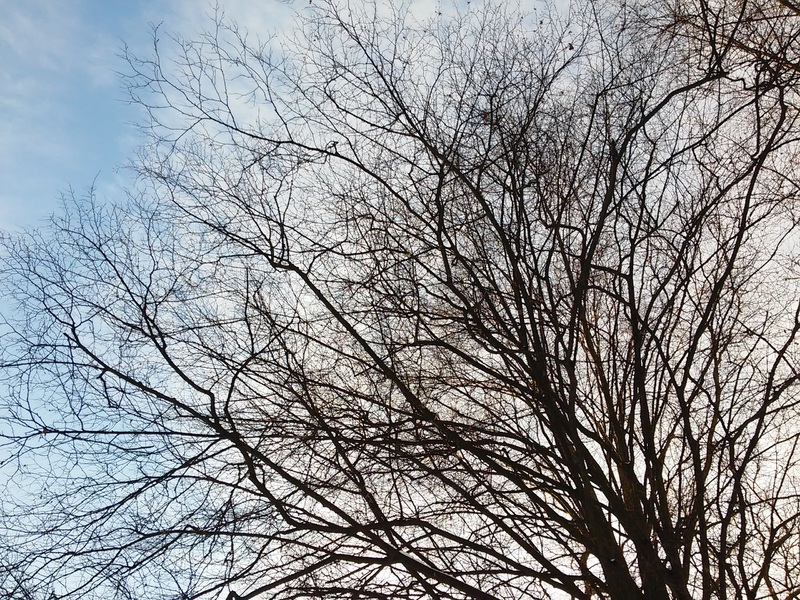
Cause: If only one side is bald, that could be a sign of root damage. It could also mean disease or pests have invaded. Dead leaves could mean a nutrient flow blockage, which is irreversible.
Cure: Depending on the extent, you may be able to save the tree with water and fertilizer, but best practice is to call an arborist for a proper diagnosis.
12. Black Lesions on Leaves
Luckily this is more a cosmetic issue related to high moisture. However, be sure to treat it to prolong the life of your tree.
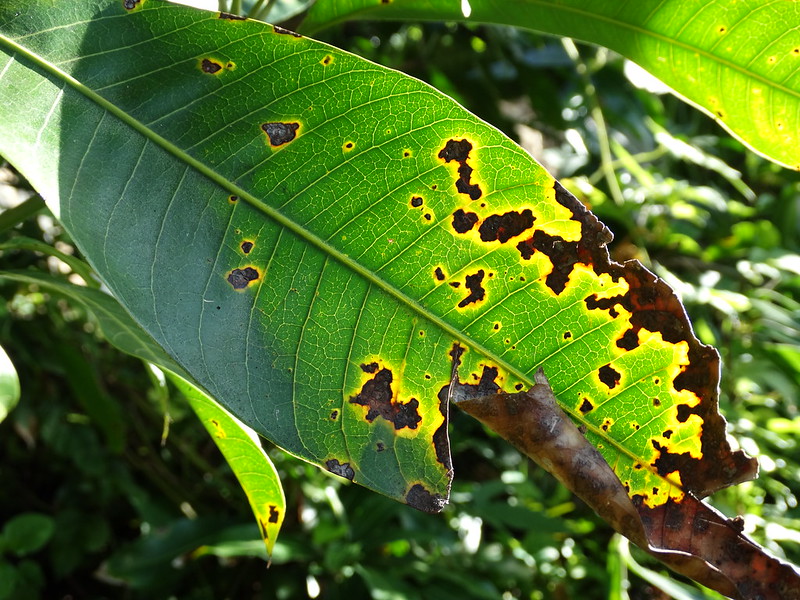
Cause: Black lesions are typically a fungus called diplocarpon rosae caused by excessive moisture. Trees in areas of high humidity and rain are especially susceptible.
Cure: Find a disease-control spray at your local garden center and follow the directions on the bottle. Typically you will want to spray the tree every seven to 14 days, as long as the weather remains humid and damp.
13. Misshapen or Discolored Leaves
Leaves that are smaller than normal, misshapen, or discolored could be a sign of drought, physical injury, or disease. It may also be the result of a seasonal or temporary problem that will correct itself in time.
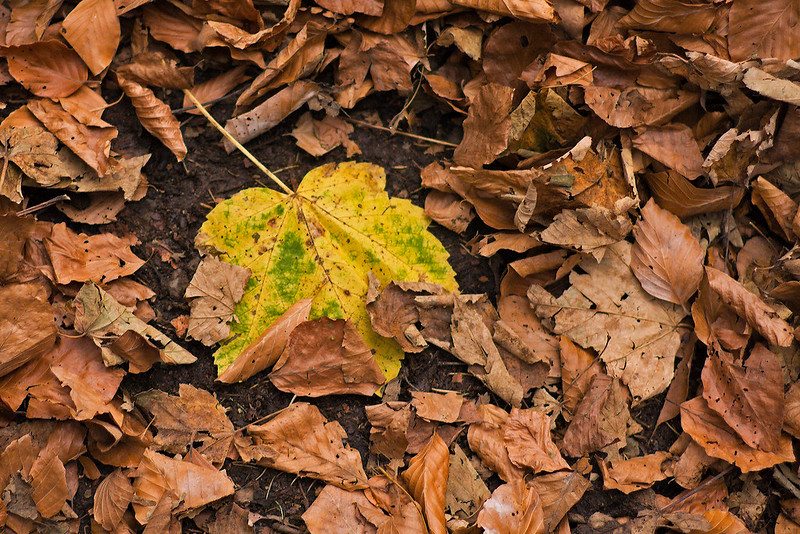
Cause: Oddly shaped or colored tree leaves often mean a problem in the soil or root system. It may signal root rot or it could also be a sign of an insect infestation.
Cure: First be sure your soil isn’t mismatched with your tree’s preferences by testing your soil. If it’s not a soil mismatch problem then you’ll want to consult a certified tree specialist for a proper diagnosis.
FAQ About Signs of a Dying Tree
Healthy trees have thick, full canopies of leaves, while a dying tree will typically have no leaves or a light, spotty canopy. There may be branches that are completely bare and some with a few leaves, but it is unlikely a dying tree would have a full canopy of leaves.
Yes, it is possible to save a dying tree. However, many variables contribute to the feasibility of bringing a tree back from the brink of death. You need to identify the root of the problem, for instance, a bug infestation is usually the secondary problem. You would need to identify the primary problem in order to save your tree. There will also be times when it will be too late to try to save your tree. If you are concerned it’s too late, call a certified tree specialist to evaluate your tree and recommend an action plan.
An ISA-certified arborist obtains extensive knowledge in tree biology, maintenance practices, safety, and other areas. To maintain their certification they must continue their education which keeps them up to date on the latest in tree care.
Arborist Services
• Pruning
• Tree Removal
• Emergency Tree Care
• Planting
• Other services may include general tree health, preventative maintenance, soil aeration, etc.
Hiring an Arborist
Whether your trees are in perfect health or if they need help, it’s wise to have a professional evaluate your trees. They will recommend treatments to help nurse a sick tree back to health or determine if it needs to come down for the safety of its surroundings.
If you need help finding a tree specialist, we’ll connect you with a local certified professional.
Main Photo by: Christine Johnstone – GeoGraph – CC BY-SA 2.0
